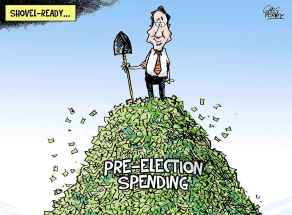Individual patients left out of wait time number game
Read this article for free:
or
Already have an account? Log in here »
To continue reading, please subscribe:
Monthly Digital Subscription
$0 for the first 4 weeks*
- Enjoy unlimited reading on winnipegfreepress.com
- Read the E-Edition, our digital replica newspaper
- Access News Break, our award-winning app
- Play interactive puzzles
*No charge for 4 weeks then price increases to the regular rate of $19.00 plus GST every four weeks. Offer available to new and qualified returning subscribers only. Cancel any time.
Monthly Digital Subscription
$4.75/week*
- Enjoy unlimited reading on winnipegfreepress.com
- Read the E-Edition, our digital replica newspaper
- Access News Break, our award-winning app
- Play interactive puzzles
*Billed as $19 plus GST every four weeks. Cancel any time.
To continue reading, please subscribe:
Add Free Press access to your Brandon Sun subscription for only an additional
$1 for the first 4 weeks*
*Your next subscription payment will increase by $1.00 and you will be charged $16.99 plus GST for four weeks. After four weeks, your payment will increase to $23.99 plus GST every four weeks.
Read unlimited articles for free today:
or
Already have an account? Log in here »
Hey there, time traveller!
This article was published 19/08/2019 (2306 days ago), so information in it may no longer be current.
It’s a common complaint: government publishes wait-time data for various medical procedures, and it rarely matches up with patients’ individual experiences.
Some wait substantially longer than what government is posting for procedures such as cataract surgery or diagnostic testing; others get served quicker than the reported times.
There’s always someone with a friend or a relative who’s been waiting two or three times longer than what government is reporting as the “median” wait time. Sometimes the disparity is so great, government is accused of posting bogus information.

There’s a reason why posted wait times don’t usually match up with patients’ individual experiences — and it’s not because government is publishing inaccurate data.
Wait times tend to vary between individual surgeons, specialists, and health-care facilities. When lumped together as median wait times, they become almost meaningless to individual patients.
The median wait time is the point at which half of patients wait longer for a procedure and half wait less.
It’s not uncommon for some patients to wait significantly longer than the median because there is no single “wait list.” Posted wait times are made up of a multitude of individual wait lists which usually differ substantially between health-care facilities.
The median wait time for cataract surgery, for example, was only three weeks at the Swan Valley Health Centre in June; it was 17 weeks at Misericordia Health Centre. Even then, wait times at Misericordia depend on who the surgeon is. There are six facilities in Manitoba that do cataract surgery, each with their own surgeons and individual wait lists.
Just because the median wait time is listed at 17 weeks, it doesn’t mean that’s what an individual patient can expect.
Wait-time data also doesn’t include the period it takes to be referred to a specialist, which can also vary widely. If such data were included, posted wait times would be substantially longer.
Government claims it has reduced wait times, which, depending on the data, may be true; critics counter wait times have been growing, which may also be true depending on how they’re measured.
Wait times for diagnostic testing — including MRIs, CT scans and ultrasounds — depend in large part on which facility patients are referred to. They, too, differ by hospital, even within Winnipeg.
The wait time for a CT scan in June, for example, was twice as long at Grace Hospital (10 weeks) as it was at Seven Oaks General Hospital (five weeks).
Posted emergency room wait times are even more muddied. The Winnipeg Regional Health Authority reports median and 90th percentile wait times (the longest wait for nine out of 10 patients), but those only measure the time it takes to see a doctor. It doesn’t include how long it takes to get treated (or if admitted to hospital, how long it takes to get a medical bed).
Also, posted ER wait times differ substantially by hospital. And they fluctuate by season. Depending on what data and timelines are used, it can be argued ER wait times are either going up or down.
That makes for great political fodder during election campaigns. Government claims it has reduced wait times, which, depending on the data, may be true; critics counter wait times have been growing, which may also be true depending on how they’re measured.
For instance, average ER wait times since the Tories launched their hospital consolidation plan in April 2017 are down slightly compared to the three years before the plan was unveiled (to 1.70 hours from 1.98 hours).
But they’ve increased somewhat since October 2017 (the month Misericordia’s urgent care centre was closed and Victoria General Hospital’s ER was converted to an urgent care centre), their opponents charge.
Both claims are accurate.
None of this means much to individual patients; each has their own wait time. Those are determined by many factors, some of which patients can control and some of which they cannot.
In some cases, patients accept longer wait times because they want a specific surgeon. In others, patients aren’t aware they may have options to reduce their wait time by switching facilities or surgeons.
The overall wait-time data reported by government and health authorities only has one purpose: to give the public and policy makers an idea of where wait times are going generally over time. If consistent methodologies are used, such data can be useful in trying to find ways to reduce delays in the system.
But they were never meant to be estimated wait times for individual patients.
Government could probably do a better job of explaining that.
tom.brodbeck@freepress.mb.ca

Tom has been covering Manitoba politics since the early 1990s and joined the Winnipeg Free Press news team in 2019.
Our newsroom depends on a growing audience of readers to power our journalism. If you are not a paid reader, please consider becoming a subscriber.
Our newsroom depends on its audience of readers to power our journalism. Thank you for your support.











